Lazy Girl’s Guide to Farming – 5 Non-Conventional Methods to Grow Food Anywhere
Rachel 04.11.18
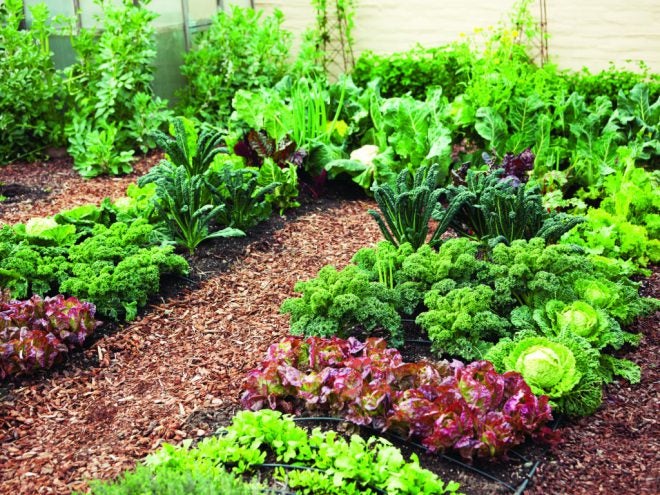
I’m a country girl at my roots. I was raised in the largest city in the world (Tokyo, at the time) and am now living back in BFE East Tennessee on my late grandmothers’ property, learning to adjust to country life once again. Think Green Acres, if that helps (some of you may need to Google it).
So, when it came to farming, I wasn’t about to spend hours in the dirt on my knees trying to force Tennessee’s finest red clay into growing anything. I certainly wasn’t going to get out there every day to pick weeds. And I didn’t have a tractor or anything to turn the soil to even START a garden.
I’m also lazy, so I’m not going to BUILD any kind of platform for the garden to grow in.
Resource List
Instead, I looked around at the resources I already had. I’d started a ‘prep stash’ of sorts. Look at my list below and see if you drew the same conclusions I did when it came to farming.
I had:
- A large, year-old compost heap
- A pile of old magazines and newspapers and burlap sacks
- A stack of wooden pallets and old tires
- Leftover concrete block from building a shed
- Out-of-control bamboo in the corner of the yard
Gardening, macgyver-style
First, I asked my neighbor to turn the compost pile. Having buried a boatload of old newspapers in my existing compost collection the year before, it turns out that I had some seriously choice compost.
Next, I filled a handful of the burlap sacks with compost and some soil, hung them from the back porch where the sunlight hit the best in the morning, and cut small holes in the sides and planted tomatoes, cucumbers, banana peppers, bell peppers, strawberries, and jalapenos – one type in each sack.
Note: when it comes to growing food outside of the ground, you’ve got to watch the soil’s nutrient levels and adjust accordingly or you’ll wind up with rot on the tomatoes and cucumbers that don’t last to maturity or ever turn green.
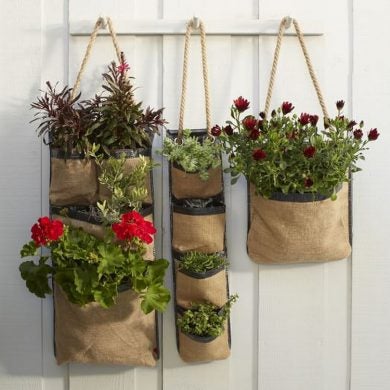
Photo courtesy of: https://www.recycled-things.com/crafts/unique-diy-hanging-planters-you-can-easily-make-at-home/
Third, I took the remaining newspaper and burlap sacks and placed them on the ground in the section of the yard I wanted to create my garden. No weeding. No turning the soil. Just set the newspaper and then the burlap right on the ground where I wanted it directly on top of the grass.
The burlap and newspapers acted as a weed barrier, but were also biodegradable so they helped the soil while still allowing the roots from the plants to get through to the soil below.
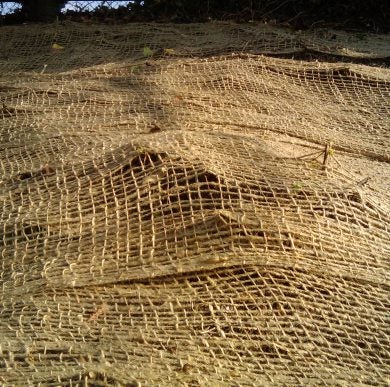
Fourth, for the cucumbers, watermelons, beans, swiss chard, corn, and kohlrabi, I turned the wooden pallets upside down and placed them on top of the newspaper and burlap I’d laid out. It turns out that they’re perfect for Square Foot Gardening – I could fit a lot of seeds into each square.
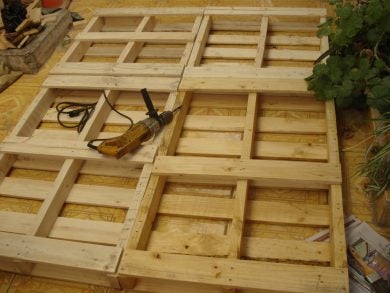
I then filled each section with compost, soil, and seeds.
Note: I obviously didn’t pair the cucumbers, watermelons, and beans in the same pallet. 🙂 I also spaced them far enough apart that the vines wouldn’t interfere with each other.
For the beans, I cut down 12 lengths of bamboo and left it in the sun to dry for several weeks beforehand. When I planted the beans, I stuck a bamboo pole (minus the leaves, etc) in each corner of the pallet and secured them in the middle at the top (like a teepee) with a zip-tie.
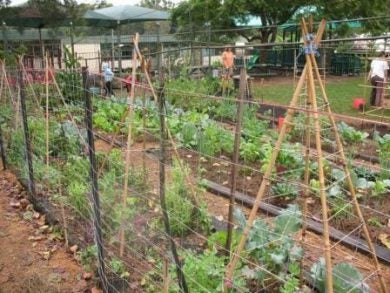
For the various types of lettuce, swiss chard, kohlrabi, and other stem-based veggies, I placed the wooden pallets rightside up on top of the newspaper and burlap.
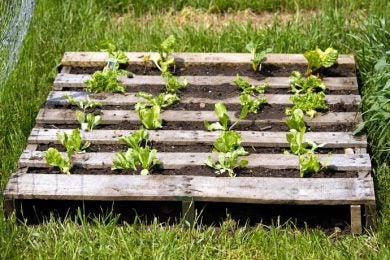
Next, I took 4 old tires and put one in each corner of the garden, filled it with compost and soil and planted my potatoes. As the stalks got higher, I added another tire and filled it with dirt and compost.
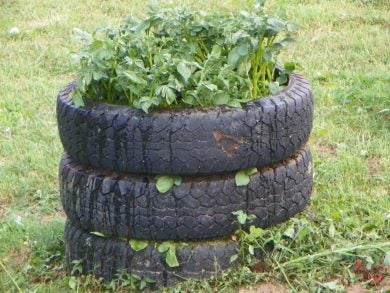
Finally, I took the concrete blocks and lined the outside of the garden with them, hole-side up. I filled them with the last of the dirt and compost and planted marigolds and herbs.
I have bees, so I wanted flowers…but the marigolds also acted as a barrier to the rest of the garden for certain insects and other critters who may want to eat the fruits of my non-labor.
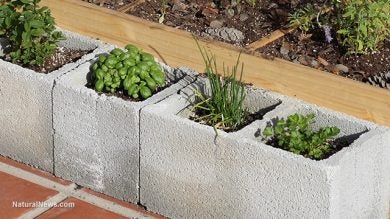
In Conclusion
And there you have it! I showed up daily to water the garden, but the weeds were virtually taken care of (I did have to get out there about once a week and pull a few).
What do you use in YOUR garden that may be unconventional? I can’t wait to hear your ideas! Share photos, please and I’ll add actual photos of my garden this year as well!